How to choose pipes for heating correctly: we understand the
Replacing or installing a heating system is a rather serious matter that requires careful study. First of all, it is necessary to decide which pipes to use for heating and how to mount the entire system correctly.
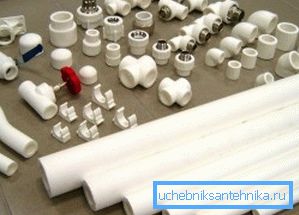
Modern materials
Previously, there was no big choice, there was simply no alternative to metal pipes. Now the modern industry has reached new heights, so you will have a difficult choice of suitable connections for the implementation of the heating system in the house.
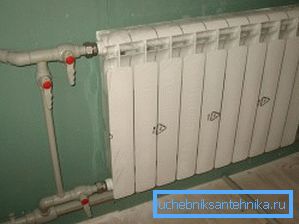
Today, the following types of pipes for heating are used for the installation of central or autonomous heating systems:
- Plastic;
- Metal-plastic;
- Copper;
- Steel;
- Stainless steel;
- Polyurethane pipes for heating.
Plastic tubing includes the following types:
- Polypropylene (PP or PP);
- Polyethylene (PE or RE);
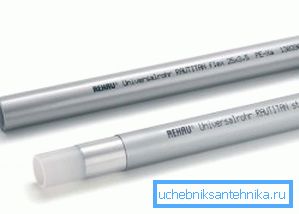
- Polyvinyl chloride (PVC).
Features of polyethylene pipes
Pipes made of conventional polyethylene are designated PE. They are primarily intended for water supply and heating systems.
This is due to the fact that polyethylene pipes for heating have the following features:
- These products tolerate minus temperature perfectly.. The working range of work is minus 20 degrees, which is why this type of pipes is appreciated in the cold period of the year, when it is necessary to repair or install heating networks located outside.
- All elements of the heat system of this material have a high level of plasticity and flexibility, which allows it to withstand various bends, because when it freezes in the nozzle, the water expands, and when it thaws, the element returns to its original shape.
Note! Experts allow the use of polyethylene, if the temperature of the coolant does not exceed 40 degrees.
Since this type of pipes is almost incompatible with high temperatures, science does not stand still. Now in production there are elements that are made of cross-linked polyethylene, they are denoted by the PEX index.
These pipes can be safely used for heat and water supply systems with hot water (water temperature can be 90 degrees). These are the brief technical characteristics of polyethylene pipes for heating, based on which it is necessary to make a choice.
Pipe for heating of corrugations
In the 1980s, the Japanese made a real revolution in the technology of pipeline installation, a unique invention saw the light, namely a corrugated pipe. After their scientific research, this material has become very popular in many countries.
Important: Corrugation reflects the commitment of the people of Japan to convenience, practicality, and most importantly to safety.
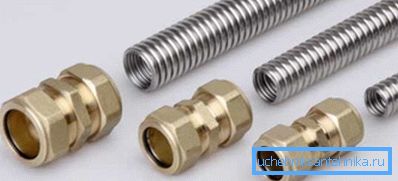
Today, corrugated pipe for heating is rightfully considered one of the most practical, it can be used in different climatic conditions, which only increases its popularity.
One of the advantages of these connections is the low price.
- The corrugation pipe for heating is made of stainless steel tape using a unique TIG-welding, which is carried out using tungsten electrodes with argon at a temperature of 1150 degrees Celsius.
- The quality of the seam is very high. This is achieved by a special test using a laser.
- A visual indicator of verification is the width of the seam, which should never exceed the wall thickness of the corrugations multiplied by a factor of 1.6.
- Further on the basis the corrugation is formed. The basic principle of its formation is heat treatment at sufficiently high temperatures (960 - 1150 degrees).
- The next stage is cooling to a temperature of 200-400 degrees. Before the product is packaged, it is thoroughly tested on special equipment that can fix any, even the smallest damage.
The main feature of the composition of this product is a low carbon content of 18%, chromium and nickel, which gives the material extremely positive properties, which make it possible to use it for household and household needs.
Corrugated pipe for heating has several disadvantages:
- Low resistance to mechanical damage;
- Non-resistant to chemical effects.
Based on the shortcomings of this element, it is not recommended to install it in places with possible mechanical damage. In order to protect the finished pipeline as much as possible, it is closed by a box.
Separately, it is worth noting that the manual installation of these pipes with their own hands is very simple, so you can handle the installation yourself.
Glass fiber reinforced polypropylene pipes
Fiberglass pipe for heating is made on the principle of a sandwich. It has two identical layers, which are located above and below, and the filling is placed in the middle.
Fiberglass pipes for heating appeared on the building materials market relatively recently, but they have already managed to prove their worth.
Fiberglass reinforcement has several advantages over reinforcement with aluminum. First, these connections should not be cleaned and calibrated during a process such as installing propylene pipes.
Tip! The fiberglass pipe has the ability to solder in the same way as a regular plastic pipe or as a cleaned polymer.
This fact significantly saves time and money during the installation of the heating system. Such pipes never stratify, because they have a homogeneous structure.
However, there is one drawback: for such pipes the linear expansion is as much as 6% larger than for elements that are reinforced with aluminum.
Metal pipes for heating systems
Steel pipes for heating systems are almost the ideal choice, because they combine an affordable price, reliability and durability.
If we consider their characteristics from the point of view of the above criteria, we can distinguish the following pros and cons:
- Steel pipes for heating according to GOST can operate at a maximum temperature of 1500 degrees Celsius. Even at such high temperatures, nozzles are not subjected to deformations;
- High level of thermal conductivity, which ensures the stability of all geometrical characteristics. This fact makes it possible to place these elements inside building structures.
- Steel is not susceptible to ultraviolet radiation.
- On top of the elements are specially coated with an anti-corrosion coating that prevents the formation of corrosion.
- Virtually all steel products, including pipes, are able to withstand hydraulic shocks, they are able to withstand critical pressure for as long as four hours.
When installing a pipeline of steel elements, a minimum number of parts is used, which fix the position of the pipes.
The main disadvantages of steel pipes:
- Corrosive tendency.
- Heavy weight.
- Incompatibility with antifreeze, which is used as a heat carrier in private households.
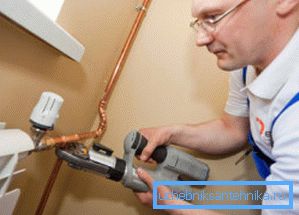
Conclusion
Now you know what pipes are needed for heating. The choice in each case depends on the technical features of the heating system and the individual preferences of the customer (see also the article Profile pipe 60 for 60: we reveal all the features).
In the presented video in this article you will find additional information on this topic.